200-901 DEVASC: Cisco Certified DevNet Associate
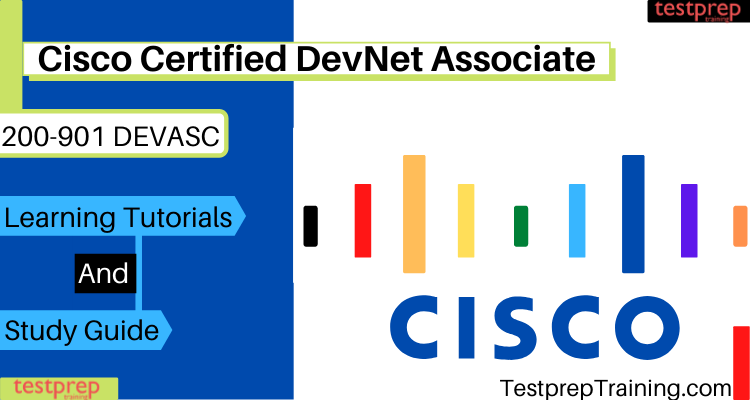
Cisco Certified DevNet Associate (200-901 DEVASC) exam validates candidate’s knowledge and skills in software development and design including a basic understanding of using APIs, Cisco platforms and development, and infrastructure and automation. In this exam, the candidates will learn about:
- Implementing basic network applications using Cisco platforms as a base
- Applying automation workflows across the network, security, collaboration, and computing infrastructure.
However, this exam gives candidates hands-on experience in solving real-world problems using Cisco Application Programming Interfaces (APIs) and modern development tools.
Knowledge required for the exam
- Cisco 200-901 DEVASC exam is designed for those who can perform a developer role. Or, they have one or more years of hands-on experience in developing and maintaining applications that are built on top of Cisco platforms.
- Candidates before taking the exam should develop a basic understanding of computer literacy and good skills in PC operating system navigation.
- Also, they must have basic Internet usage skills and hands-on experience with a programming language (specifically Python).
Target Audience
Cisco 200-901 DEVASC exam is appropriate for:
- Software developers
- Application developers
- Network engineers

Learning Objectives
Cisco provides various learning objectives for the 200-901 DEVASC exam in which candidates will develop skills and knowledge. However, after passing the exam candidates will be able to perform various tasks that include:
- Describing the importance of APIs and using version control tools in modern software development
- Describing common processes and practices used in software development including options for organizing and constructing modular software
- Explaining HTTP concepts and how they apply to network-based APIs
- Applying Representational State Transfer (REST) concepts got integration with HTTP-based APIs
- Describing Cisco platforms and their capabilities and programmability features of different Cisco platforms
- Identifying common application deployment models and components in the development pipeline
- Utilizing tools to automate infrastructure through scripting and model-driven programmability
Exam Details
For Cisco Certified DevNet Associate (200-901 DEVASC) exam candidates will get 120 minutes to complete the exam. The exam can contain various questions types that can be Multiple-Choice Single Answer, Multiple-Choice Multiple Answer & Drag and Drop Fill-in-the-Blank & Testlet. However, for passing scores, Cisco does not publish exam passing scores because exam questions and passing scores are subject to change without notice. This exam is available in English and Japanese language. The cost of the exam is $300 USD and the exam is valid for three years.
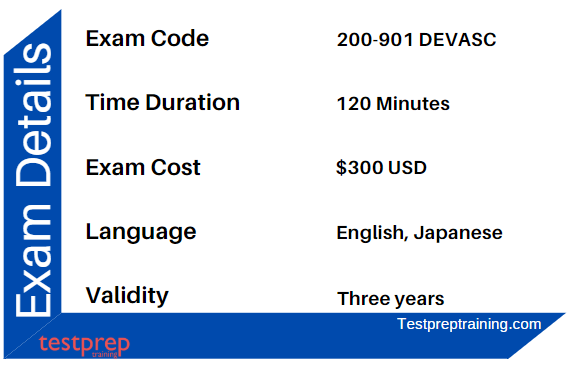
Exam Scheduling
For Cisco Certified DevNet Associate (200-901 DEVASC) exam scheduling, candidates have to follow some steps that are:
- Log into your account at Pearson VUE.
- There, select the Proctored exam and enter the exam number, 200-901.
- Follow the prompts to register.
After that, once you have successfully scheduled your exam appointment, a confirmation email will be sent with your appointment details and important things to know for the exam.
Course Structure
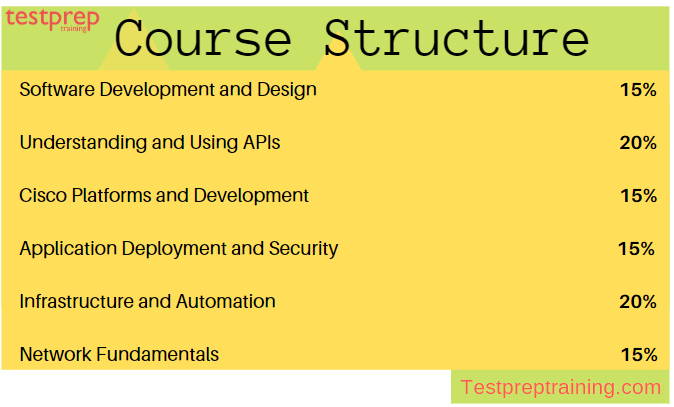
Topic 1: Software Development and Design
1.1 Comparing data formats (XML, JSON, and YAML) (Cisco Reference: Cisco XML API Overview)
1.2 Describing parsing of common data format (XML, JSON, and YAML) to Python data structures
1.3 Describing the concepts of test-driven development
1.4 Comparing software development methods (agile, lean, and waterfall) (Cisco Reference: Development process, Agile Product Development at Cisco)
1.5 Explaining the benefits of organizing code into methods / functions, classes, and modules (Cisco Reference:
1.6 Identifying the advantages of common design patterns (MVC and Observer)
1.7 Explaining the advantages of version control
1.8 Utilizing common version control operations with Git
- Clone
- Add/remove
- Commit
- Push / pull
- Branch
- Merge and handling conflicts
- diff
Topic 2: Understanding and Using APIs
2.1 Constructing a REST API request to accomplish a task given API documentation (Cisco Reference: Cisco APIC REST API Configuration Guide)
2.2 Describing common usage patterns related to webhooks
2.3 Identifying the constraints when consuming APIs (Cisco Reference: RESTful Constraints)
2.4 Explaining common HTTP response codes associated with REST APIs (Cisco Reference: Reviewing the API Documentation)
2.5 Troubleshooting a problem given the HTTP response code, request and API documentation
2.6 Identifying the parts of an HTTP response (response code, headers, body)
2.7 Utilizing common API authentication mechanisms: basic, custom token, and API keys (Cisco Reference: Authentication and Web Security)
2.8 Comparing common API styles (REST, RPC, synchronous, and asynchronous)
2.9 Constructing a Python script that calls a REST API using the requests library
Topic 3: Cisco Platforms and Development
3.1 Constructing a Python script that uses a Cisco SDK given SDK documentation (Cisco Reference: Getting Started with the Cisco Nexus 9000 Series Python SDK)
3.2 Describing the capabilities of Cisco network management platforms and APIs (Meraki, Cisco DNA Center, ACI, Cisco SD-WAN, and NSO)
3.3 Describing the capabilities of Cisco compute management platforms and APIs (UCS Manager, UCS Director, and Intersight) (Cisco Reference: Cisco UCS Manager)
3.4 Explaining the capabilities of Cisco collaboration platforms and APIs (Webex Teams, Webex devices, Cisco Unified Communication manager including AXL and UDS interfaces, and Finesse) (Cisco Reference: Cisco Webex)
3.5 Describing the capabilities of Cisco security platforms and APIs (Firepower, Umbrella, AMP, ISE, and ThreatGrid) (Cisco Reference:
3.6 Describing the device level APIs and dynamic interfaces for IOS XE and NX-OS (Cisco Reference: Cisco IOS XE Programmability)
3.7 Identifying the appropriate DevNet resource for a given scenario (Sandbox, Code Exchange, support, forums, Learning Labs, and API documentation) (Cisco Reference: DevNet Sandbox, DevNet Developer Support, Accessing DevNet Learning Labs, Cisco Developer Documentation)
3.8 Applying concepts of model-driven programmability (YANG, RESTCONF, and NETCONF) in a Cisco environment (Cisco Reference: Rise of Network Automation)
3.9 Constructing code to perform a specific operation based on a set of requirements and given API reference documentation such as these:
- Obtaining a list of network devices by using Meraki, Cisco DNA Center, ACI, Cisco (Cisco Reference: Cisco DNA Center Solution Overview)
- SD-WAN, or NSO (Cisco Reference: Common Use Cases)
- Managing spaces, participants, and messages in Webex Teams (Cisco Reference: Cisco Webex Teams)
- Obtaining a list of clients/hosts seen on a network using Meraki or Cisco DNA
- Center
Topic 4: Application Deployment and Security
4.1 Describing benefits of edge computing (Cisco Reference: Edge Computing, What Is Edge Computing)
4.2 Identifying attributes of different application deployment models (private cloud, public cloud, hybrid cloud, and edge) (Cisco Reference: Implement a Hybrid Cloud Strategy)
4.3 Identifying the attributes of these application deployment types
- Virtual machines (Cisco Reference: Deployment Types and Recommendations)
- Bare metal
- Containers (Cisco Reference: Overview of Application Containers)
4.4 Describing components for a CI/CD pipeline in application deployments (Cisco Reference: Build a Network Configuration CICD Pipeline)
4.5 Constructing a Python unit test (Cisco Reference:
4.6 Interpreting contents of a Dockerfile (Cisco Reference: Docker Commands)
4.7 Utilizing Docker images in local developer environment (Cisco Reference: Docker Tooling for IOx Application Development)
4.8 Identifying application security issues related to secret protection, encryption (storage and transport), and data handling
4.9 Explaining how firewall, DNS, load balancers, and reverse proxy in application deployment (Cisco Reference: Protecting Web Applications with Web Application Firewall, Deploying Load Balancing)
4.10 Describing top OWASP threats (such as XSS, SQL injections, and CSRF) (Cisco Reference: Understanding SQL Injection)
4.11 Utilizing Bash commands (file management, directory navigation, and environmental variables)
4.12 Identifying the principles of DevOps practices
Topic 5: Infrastructure and Automation
5.1 Describing the value of model-driven programmability for infrastructure automation (Cisco Reference: Rise of Network Automation, Model-Driven Programmability)
5.2 Comparing controller-level to device-level management (Cisco Reference: Cisco DNA Center Solution Overview)
5.3 Describing the use and roles of network simulation and test tools (such as VIRL and pyATS) (Cisco Reference: pyATS Demos, Automation/Code Exchange)
5.4 Explaining the components and benefits of CI/CD pipeline in infrastructure automation (Cisco Reference: Continuous Integration/Continuous Delivery (CI/CD))
5.5 Describing principles of infrastructure as code
5.6 Explain the capabilities of automation tools such as Ansible, Puppet, Chef, and Cisco NSO
5.7 Identifying the workflow being automated by a Python script that uses Cisco APIs including ACI, Meraki, Cisco DNA Center, or ESTCONF
5.8 Identifying the workflow being automated by an Ansible playbook (management packages, user management related to services, basic service configuration, and start/stop) (Cisco Reference: Cisco with Ansible)
5.9 Identifying the workflow being automated by a bash script (such as file management, app install, user management, directory navigation)
5.10 Interpreting the results of a RESTCONF or NETCONF query (Cisco Reference: RESTCONF Programmable Interface, Cisco NETCONF and REST Device Management API Documentation)
5.11 Explain basic YANG models (Cisco Reference: YANG Infrastructure, Configure NETCONF/YANG)
5.12 Interpreting a unified diff
5.13 Describing the principles and benefits of a code review process
5.14 Interpreting sequence diagram that includes API calls (Cisco Reference: Sequence Diagrams for Components)
Topic 6: Network Fundamentals
6.1 Describing the purpose and usage of MAC addresses and VLANs (Cisco Reference: Managing the MAC Address Table)
6.2 Describing the purpose and usage of IP addresses, routes, subnet mask / prefix, and gateways (Cisco Reference: IP Addressing and Subnetting for New Users, IP Addressing Guide)
6.3 Explaining the function of common networking components (such as switches, routers, firewalls, and load balancers) (Cisco Reference: Switch Working, Router, Firewall, Load Balancing)
6.4 Interpreting a basic network topology diagram with elements such as switches, routers, firewalls, load balancers, and port values
6.5 Describing the function of management, data, and control planes in a network device
6.6 Explain the functionality of these IP Services: DHCP, DNS, NAT, SNMP, NTP (Cisco Reference: Configuring the Cisco IOS DHCP Server, Configuring DNS, Configuring NAT for IP Address Conservation, Configuring SNMP Support, Configuring NTP)
6.7 Recognizing common protocol port values (such as, SSH, Telnet, HTTP, HTTPS, and NETCONF) (Cisco Reference: Configuring Secure Shell (SSH), Configuring Telnet, HTTP/HTTPS Services Configuration Guide, NETCONF Protocol)
6.8 Identifying cause of application connectivity issues (NAT problem, Transport Port blocked, proxy, and VPN)
6.9 Explaining the impacts of network constraints on applications
For Reference: Cisco 200-901 Exam Guide
Exam Policies
Cisco includes various exam policies to help candidates understand the terms and procedures for the certification exam. Some of them include:
Exam Retake Policy
Cisco exam retakes policy states that candidates who fail an Associate, Professional, Specialist, or CCDE Written exam must have to wait for five calendar days, beginning the day after the failed attempt. However, once passed, a candidate must wait for a minimum of 180 days before taking the same exam with an identical exam number.
Exam Reschedule Policy
Candidates who want to reschedule their online proctored exam must contact Pearson VUE or access an online Pearson VUE account to reschedule the exam up until the scheduled start time of your appointment. However, failure to reschedule before your appointment time or failure to appear for your appointment will result in the forfeiture of your exam fee.
Cancellation Policy
To cancel online proctored exam candidates must contact Pearson VUE or access your online Pearson VUE account to cancel your exam up until the scheduled start time of your appointment. However, failure to cancel before your appointment time or failure to appear for your appointment will result in the forfeiture of your exam fee.
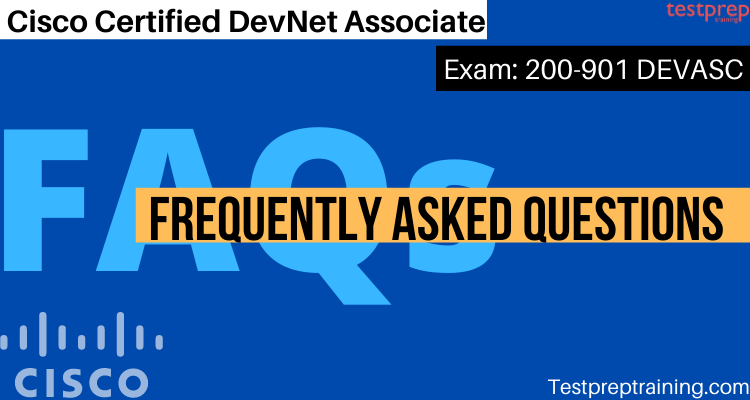
For More Visit: Cisco DevNet Associate (200-901 DEVASC) Exam FAQs
Preparation Guide for Cisco 200-901 DEVASC Exam
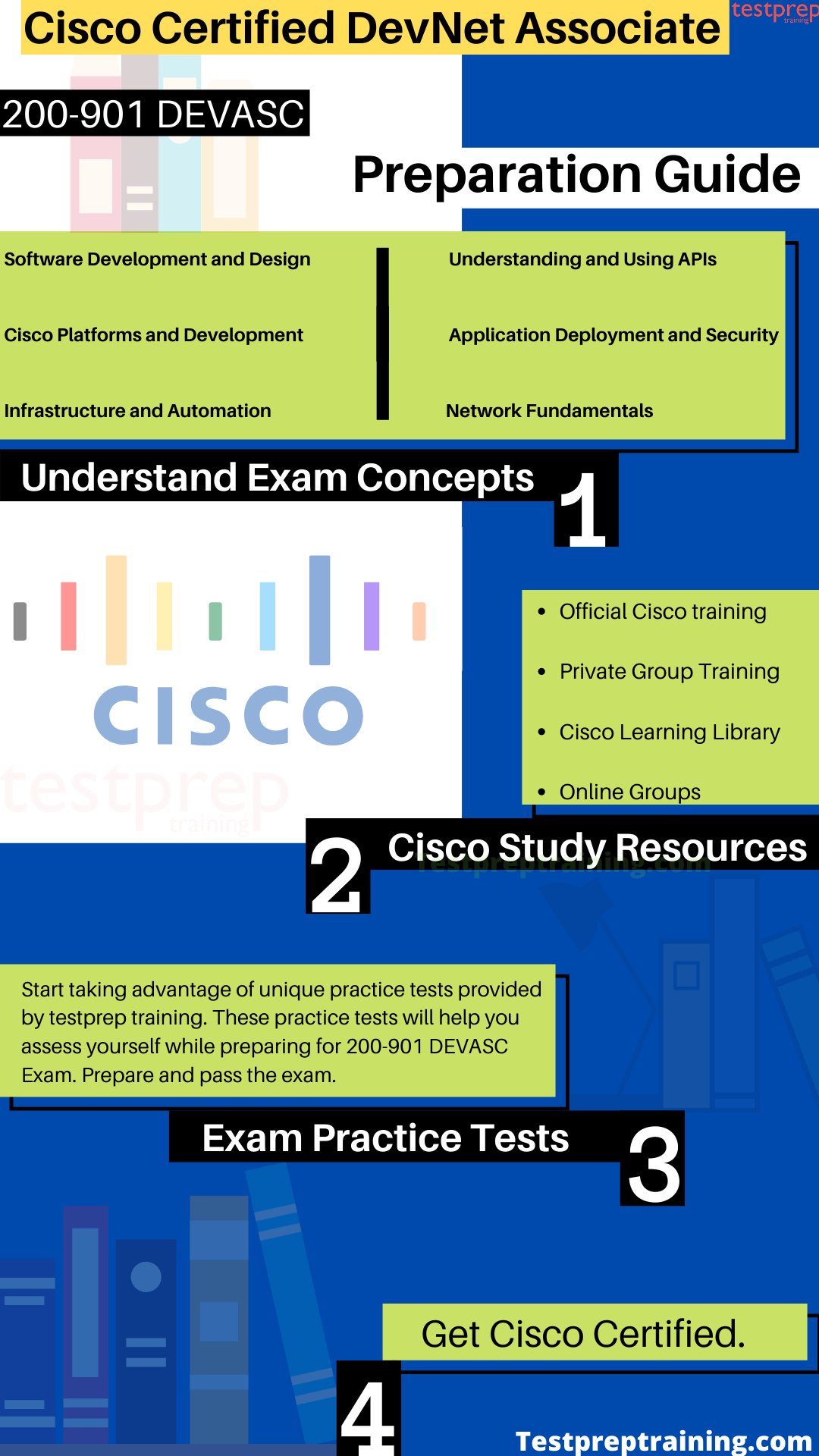
 Official Cisco training
Official Cisco training
Cisco provides an official training course to help candidates prepare for the 200-901 DEVASC exam that is, the Developing Applications and Automating Workflows Using Cisco Platforms (DEVASC) v1.0 course. In this training course, candidates will learn and understand about implementing basic network applications using Cisco platforms and automation workflows across the network, security, and computing infrastructure. Moreover, this course also gives hands-on experience in solving real-world problems using Cisco Application Programming Interfaces (APIs) and modern development tools. However, this includes various objectives in which the candidates will enhance their skills and knowledge. Some of them are:
- Practicing Modern Software Development
- Describing Software Development Process
- Designing Software
- Introducing Network-Based APIs
- Consuming REST-Based APIs
- Employing Programmability on Cisco Platforms
- Introducing Cisco Platforms
- Describing IP Networks (ELT only)
- Employing Model-Driven Programmability with YANG
- Testing and Securing Applications
- Automating Infrastructure
 Private Group Training
Private Group Training
Cisco offers candidates Private group training that brings the Cisco classroom experience anywhere, whether it’s an office, or to an offsite location of your choice. This can deliver any Cisco course in this format, from certification classes to the latest technology and business transformation training. Moreover, Private group training is a convenient, cost-effective choice for groups with many people who all need the same training.
 Cisco Learning Library
Cisco Learning Library
Cisco provides a Learning Library to help candidates to gain foundational knowledge and skills for all network needs. However, this new library includes the Cisco Platinum Learning Library and Cisco Technical Knowledge Library for a great price. Cisco Learning Library for DevNet is an online DevNet certification training program that helps candidates to explore new opportunities in application design, software development, and automation. Moreover, this comprehensive technical training library includes full-length interactive DevNet certification courses, with labs, and thousands of reference materials. In addition, it gives candidates access to the Cisco Technical Knowledge Library that comes with best practices, design guides, and live webinars.
Online Study Groups
One thing that will be beneficial during the exam preparation time is to join study groups. These groups will help you to stay connected with the other people who are on the same pathway as yours. Moreover, here you can start any discussion about the issue related to the exam or any query. By doing so, you will get the best possible answer to your query.
Practice Tests
This can be a very essential part that can help you to prepare better for the exam. That is to say, practice tests are important as by assessing yourself with these tests you will know about your weak and strong areas. However, by practicing you will be able to improve your answering skills that will result in saving a lot of time. Moreover, the best way to start doing practice tests is after completing one full topic as this will work as a revision part for you. So, make sure to find the best practice sources.

